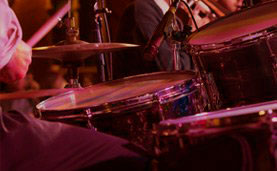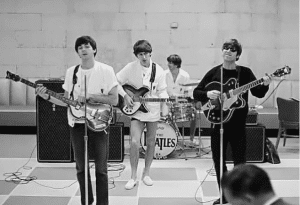5 Greatest Songs That Feature A Cowbell

via Jimi Hendrix / YouTube
As that iconic sketch once proclaimed, “more cowbell” it is. The cowbell might seem like an unlikely rock instrument, but its distinct sound has left a lasting mark on some of the greatest songs ever recorded. More than just a simple percussion piece, it adds a unique rhythm that stands out in a mix of guitars, drums, and vocals. When used right, it can turn a good song into an unforgettable one.
While many people associate the cowbell with a certain Saturday Night Live skit, its presence in rock music goes far beyond that. Some of the most iconic tracks have relied on its unmistakable clank to drive the beat and create an irresistible groove. It’s a small instrument with a big impact.
This list highlights five of the greatest songs that feature the cowbell in all its glory—excluding the one that’s been memed to oblivion. From classic rock anthems to
“Born On The Bayou” – Creedence Clearwater Revival
“Born On The Bayou” is a standout track from Creedence Clearwater Revival’s 1969 album Bayou Country. The song showcases John Fogerty’s distinctive gravelly vocals, which are complemented by the cowbell’s resonant sound, creating a gritty atmosphere reminiscent of the American South. This pairing enhances the swamp rock vibe that CCR is known for, making the cowbell an integral part of the song’s identity.
The lyrics evoke imagery of bayous and Southern landscapes, further immersing listeners in a unique auditory experience. The cowbell’s rhythmic presence adds depth to the instrumentation, making it feel both raw and authentic. This track exemplifies how a simple instrument can elevate the overall feel of a song, contributing to its lasting legacy in rock music.
CCR’s influence on American rock is undeniable, with Bayou Country marking a pivotal point in their career. The album not only included hits like “Proud Mary” but also solidified CCR’s reputation for blending rock with traditional American sounds
“Stone Free” – Jimi Hendrix
Jimi Hendrix’s “Stone Free” begins with an unmistakable cowbell rhythm that immediately captures attention. This persistent sound acts like a heartbeat throughout the track, enhancing its dynamic energy and complementing Hendrix’s powerful guitar riffs. The cowbell serves as both a percussive element and a melodic accent, showcasing Hendrix’s innovative approach to music.
The song reflects themes of freedom and rebellion, aligning perfectly with the counterculture movement of the 1960s. Hendrix’s raw vocal delivery combined with the cowbell creates an exhilarating listening experience that draws listeners into his world. It’s a prime example of how Hendrix pushed musical boundaries, integrating various elements to create something truly unique.
“Stone Free” has become an enduring classic, celebrated for its boldness and creativity. The cowbell’s role in this track highlights its versatility as an instrument, proving that it can be both subtle and striking in rock music.
“Low Rider” – WAR
WAR’s “Low Rider” features one of the most recognizable cowbell parts in popular music. The cowbell maintains a steady presence throughout the song, driving its infectious groove and making it instantly danceable. This rhythmic foundation allows other instruments, such as horns and bass, to shine while keeping the overall sound cohesive.
The song celebrates Chicano culture and lowrider cars, resonating with audiences through its catchy melody and relatable themes. Its widespread popularity has led to numerous appearances in movies, TV shows, and commercials, further embedding it into pop culture.
The cowbell’s contribution to this track is not just musical; it embodies the spirit of fun and community associated with lowrider culture. “Low Rider” has transcended generations, remaining relevant in various media contexts. Its distinctive sound continues to inspire new artists while paying homage to its roots in funk and rock.
“We’re an American Band” – Grand Funk Railroad
In “We’re an American Band,” Grand Funk Railroad uses the cowbell right from the start to set an energetic tone for the song. Its rhythmic introduction prepares listeners for an anthem celebrating American life and rock music culture. The cowbell’s sharp strikes create anticipation for the powerful instrumentation that follows.
The lyrics reflect themes of travel and camaraderie among band members on tour, resonating with fans who appreciate classic rock storytelling. The cowbell enhances this narrative by adding a layer of excitement that mirrors the band’s experiences on the road. It becomes an essential part of their signature sound during this era.
Grand Funk Railroad achieved significant commercial success with this track, which remains a staple at classic rock radio stations. The use of cowbell here exemplifies how simple elements can contribute significantly to a song’s impact.
“Honky Tonk Women” – The Rolling Stones
The Rolling Stones’ “Honky Tonk Women” features the cowbell prominently, setting the stage for one of their most iconic tracks. Its distinctive sound introduces listeners to a honky-tonk atmosphere that perfectly complements Mick Jagger’s storytelling style. The cowbell adds authenticity to the song’s country-infused rock vibe.
This track explores themes of love and nightlife in classic Stones fashion, with lyrics that paint vivid pictures of barroom encounters. The rhythmic interplay between guitar riffs and cowbell creates an engaging sonic landscape that captivates audiences worldwide. It demonstrates how diverse influences can merge seamlessly within rock music.
“Honky Tonk Women” has become synonymous with The Rolling Stones’ legacy as pioneers in blending genres. The use of cowbell not only enhances this particular song but also showcases its versatility across their discography. Its infectious groove continues to resonate with fans old and new, solidifying its place in rock history.
















